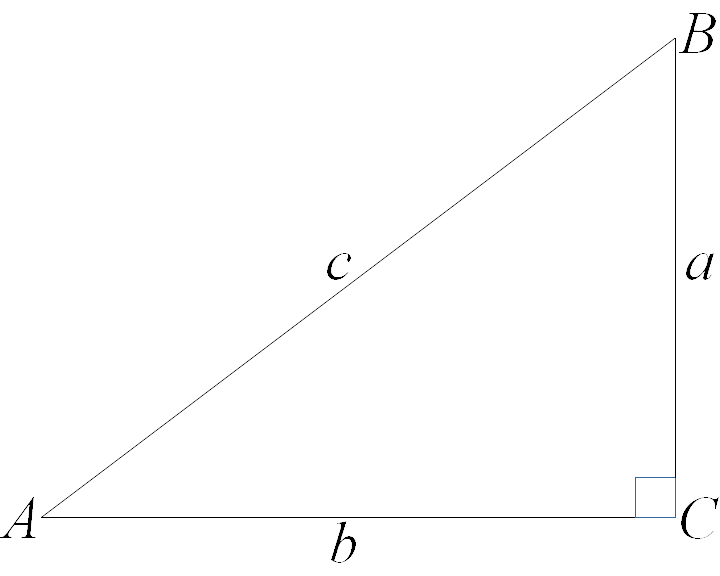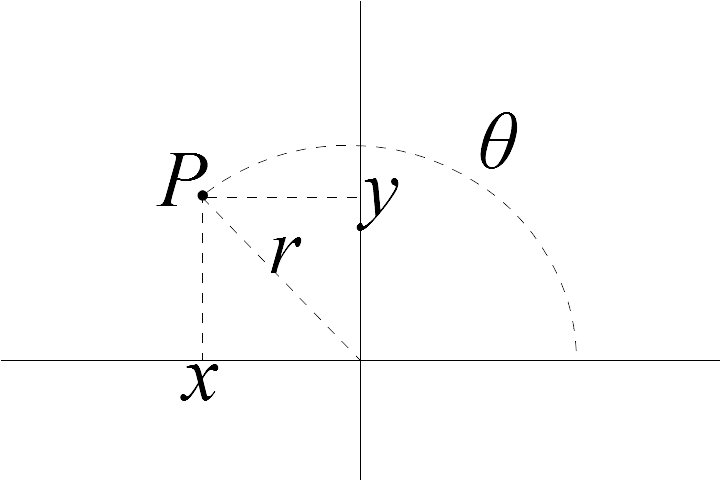Overview
While trigonometry can be intimidating to some, it need not be, as long as we start with the concept of similar triangles—that is, any 2 triangles with the same proportions between all 3 side lengths have the same interior angles, and any 2 triangles with the same 3 interior angles have the same proportions between side lengths.
Right triangles
 Figure 1: Right triangle used to define basic trigonometric relationships.
Figure 1: Right triangle used to define basic trigonometric relationships.
Trigonometric functions are initially defined in terms of the angles and sides in a right triangle, for acute angles only—i.e. in the interval $\left [ 0, \pi / 2 \right )$. By convention, each vertex is identified by an upper-case letter (most commonly, A, B, and C, for the two acute angles and the right angle, respectively), with the side opposite identified by the same letter, but lower-case. Note that an upper-case letter denotes not only a vertex, but the measure of the angle at that vertex; similarly, a lower-case letter refers not only to the side itself, but to the length of that side. Finally, the right angle is identified by a small square at vertex C.
All of the definitions in the following table are in reference to the triangle in figure 1, above.
| Measure | Definition | Java method |
|---|---|---|
| Sine | $\sin A = \dfrac{a}{c}$ | double Math.sin(double angle) |
| Cosine | $\cos A = \dfrac{b}{c}$ | double Math.cos(double angle) |
| Tangent | $\tan A = \dfrac{a}{b}$ | double Math.tan(double angle) |
| Arcsine | $\arcsin \dfrac{a}{c} = A$ | double Math.asin(double ratio) |
| Arccosine | $\arccos \dfrac{b}{c} = A$ | double Math.acos(double ratio) |
| Arctangent | $\arctan \dfrac{a}{b} = A$ | double Math.atan(double ratio) |
| Pythagorean theorem | $c = \sqrt{a^2 + b^2}$ | double Math.hypot(double a, double b) |
Polar coordinates
 Figure 2: Position of point $P$ shown in polar and Cartesian coordinates.
Figure 2: Position of point $P$ shown in polar and Cartesian coordinates.
The position of a point $P$ on a plane is usually expressed either with respect to the $X$ and $Y$ axes—that is, in Cartesian coordinates—or with respect to a pole (coincident with the origin of the Cartesian coordinate system) and a polar axis (coincident with the positive $X$ axis of the Cartesian coordinate system). The coordinates used in the latter case are called polar coordinates, and consist of a distance, $r$, measured from the pole, and an angle, $\theta$, measured counter-clockwise from the polar axis. When $\theta$ is in the interval $\left [ 0, \pi / 2 \right )$, the $x$, $y$, and $r$ values form a right triangle, where $\theta$ is the angle opposite $y$. Recognizing this, we can extend the trigonometric relationships beyond acute angles in an intuitive fashion, by expressing them in terms of polar and Cartesian coordinates, allowing $x$ and $y$ to take negative values, and allowing $\theta$ to take values outside the interval $\left [ 0, \pi / 2 \right )$.
All of the definitions in the following table are in reference to the polar and Cartesian coordinate system used in the example shown in figure 2, above.
| Measure | Definition | Java method |
|---|---|---|
| Sine | $\sin \theta = \dfrac{y}{r}$ | double Math.sin(double angle) |
| Cosine | $\cos \theta = \dfrac{x}{r}$ | double Math.cos(double angle) |
| Tangent | $\tan \theta = \dfrac{y}{x}$ | double Math.tan(double angle) |
| Arcsine | $\arcsin \dfrac{y}{r} = \theta$ | double Math.asin(double ratio) |
| Arccosine | $\arccos \dfrac{x}{r} = \theta$ | double Math.acos(double ratio) |
| Arctangent | $\arctan \dfrac{y}{x} = \theta$ | double Math.atan2(double y, double x) |
| Pythagorean theorem | $r = \sqrt{x^2 + y^2}$ | double Math.hypot(double x, double y) |
Note that the tangent function has a period of $\pi$, instead of $2\pi$ (the period of the sine and cosine functions). Thus, in order to properly distinguish between $\theta$ values across the full $\left[0, 2\pi \right)$ interval, the Math.atan2 method takes both y and x as parameters, rather than just the ratio of the two. This also gives us a clean way to evaluate the arctangent in cases where the ratio is not finite (e.g. for $\theta = \pi /2$ and $\theta = 3\pi /2$).